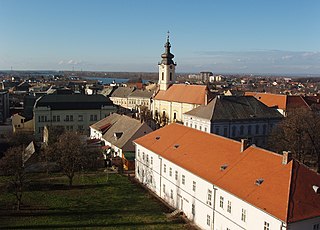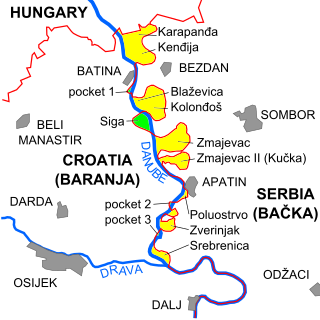
Vojvodina, officially the Autonomous Province of Vojvodina, is an autonomous province that occupies the northernmost part of Serbia, located in Central Europe. It lies within the Pannonian Basin, bordered to the south by the national capital Belgrade and the Sava and Danube Rivers. The administrative centre, Novi Sad, is the second-largest city in Serbia.

Sremska Mitrovica is a city in Serbia. It is situated on the left bank of the Sava river. As of 2022, the city has a total population of 40,144 inhabitants, while its administrative area has a population of 72,580 inhabitants.
Bunjevci are a South Slavic sub-ethnic group of Croats living mostly in the Bačka area of northern Serbia and southern Hungary, particularly in Baja and surroundings, in Croatia, and in Bosnia-Herzegovina. They presumably originate from western Herzegovina. As a result of the Ottoman conquest, some of them migrated to Dalmatia, from there to Lika and the Croatian Littoral, and in the 17th century to the Bácska area of Hungary.

Vojvodina is a province in Republic of Serbia and one of the most ethnically diverse regions in Europe, home to 25 different ethnicities.

The Democratic Alliance of Croats in Vojvodina is a political party in Serbia, representing the Croat ethnic minority in the province of Vojvodina.

The Bunjevac dialect, also known as Bunjevac speech, is a Neo-Shtokavian Younger Ikavian dialect of the Serbo-Croatian pluricentric language, preserved among members of the Bunjevac community mostly in the Bačka area of northern Serbia and southern Hungary, particularly in Baja and surroundings. It is also found in Croatia, and in Bosnia-Herzegovina. They presumably originate from western Herzegovina. Their accent is purely Ikavian, with /i/ for the Common Slavic vowels yat.

The Croatian Bunjevac-Šokac Party was a political party in Serbia that represented the Croat ethnic minority in the province of Vojvodina.

Croats of Serbia or Serbian Croats are a recognized national minority in Serbia. According to the 2022 census, the population of ethnic Croats in Serbia is 39,107, constituting 0.6% of the total population. The vast majority of them live in the northern autonomous province of Vojvodina, where they number 32,684 and make up 1.9% of the province's population. An additional 11,104 people declared themselves as Bunjevci in the 2022 census; there are differing views whether Bunjevci should be regarded as Croats or as members of a distinct ethnic group. The majority of the Sokac community consider themself as Croats. Not all Croats have Bunjevac or Sokac ancestors.
Dražen Prćić is Croatian novelist from area of Bačka, autonomous province of Vojvodina, Serbia.

The Democratic Union of Croats is a political party in Serbia representing the Croat ethnic minority in the province of Vojvodina.
The Croatian National Alliance was a political party of ethnic Croats in autonomous province of Vojvodina, Serbia.

Muftiship of Novi Sad is one of the four muftiships of the Islamic Community in Serbia. Muftiship is including territory of the Autonomous Province of Vojvodina and its seat is in Novi Sad. Administrator of the muftiship is mufti Fadil Murati.

Croatian National Council of the Republic of Serbia is the representative body of Croats in Serbia, established for the protection of the rights and the minority self-government of Croats in Serbia.

The border between Croatia and Serbia in the area of the Danube is disputed, an important part of their broader diplomatic relations. While Serbia claims that the thalweg of the Danube valley and the centreline of the river represents the international border between the two countries, Croatia disagrees, claiming that the international border lies along the boundaries of the cadastral municipalities located along the river—departing from the course at several points along a 140-kilometre (87 mi) section. The cadastre-based boundary reflects the course of the Danube which existed in the 19th century, before anti-meandering and hydrotechnical engineering works altered its course. The area size of the territory in dispute is reported variously, up to 140 km2.

The Cathedral Basilica of St. Demetrius also called Sremska Mitrovica Cathedral is the name given to a Roman Catholic church which is located in the city of Sremska Mitrovica, in the autonomous province of Vojvodina, Serbia.

Tomislav Žigmanov is a Serbian politician serving as minister of human and minority rights and social dialogue since 2022. An ethnic Croat, he has been the president of the Democratic Alliance of Croats in Vojvodina (DSHV) since 2015. He served in the National Assembly of Serbia from 2016 to 2020, and again from 1 August 2022 to 25 October 2022.
Živko Vrcelj is a medical doctor and politician in Serbia. He was a member of the Assembly of Vojvodina from 2012 to 2016 and briefly served in the National Assembly of Serbia in 2016 as a member of the Serbian Progressive Party. Vrcelj is currently the director of the Sremska Mitrovica General Hospital.
Mirko Ostrogonac is a Serbian politician and agronomy engineer serving as a member of the National Assembly since 26 October 2022. An ethnic Croat, he is a high-ranking member of the Democratic Alliance of Croats in Vojvodina (DSHV).
Vojvodina Front was a parliamentary group in the Assembly of Vojvodina. It was chaired by Saša Šućurović while Aleksandar Odžić served as deputy chairman.













